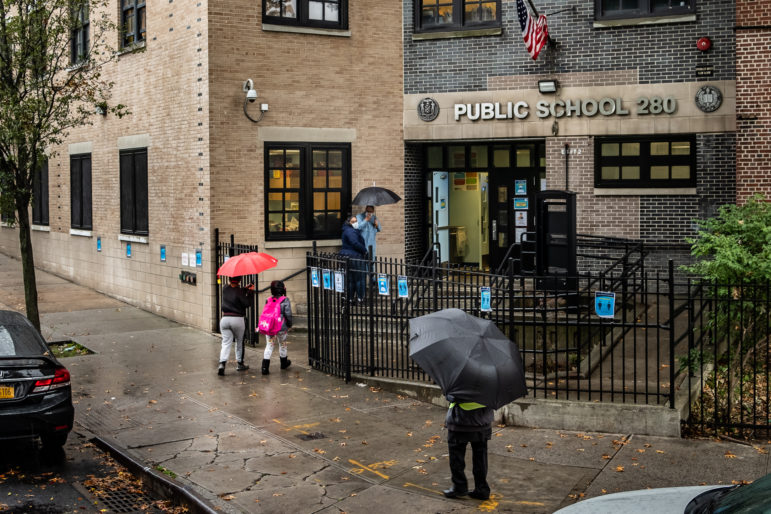A new report by Citizens’ Committee for Children of New York, released Monday, analyzed pre-pandemic data to determine where the level of various risks to families’ well-being stood before the COVID-19 crisis.

Adi Talwar
A late October Monday Morning in front of Public School 280 in the Bronx.The pandemic has caused families in New York to experience magnified levels of trauma in multiple ways, including illness, losing loved ones, financial distress and housing insecurity. A new report by Citizens’ Committee for Children of New York, released Monday, analyzed pre-pandemic data to determine where the level of various risks to families’ well-being stood before the COVID-19 crisis — and found that families in the Bronx are facing some of the biggest threats, compared to other counties in the state.
The report assessed these risks to children and families by looking at 18 different indicators related to specific “domains of well-being,” analyzing data collected between 2015 and 2018 for each New York county, including child poverty rates, income levels, graduation rates, and the prevalence of overcrowded rental housing. The findings further reveal the troubling disparities that existed before the current health and economic crises, especially given how COVID-19 has intensified these risks, according to the group.
The information is also intended to guide policy decisions and set legislative priorities for New York’s COVID-19 recovery plans, CCC says, especially as Gov. Andrew Cuomo outlines his 2021 agenda in four State of the State speeches this week.
“The findings in this report also make clear that child and family needs must be prioritized in state budget, legislative, and policy decision-making if New York State is to effectively promote recovery,” the report reads.
CCC found that families in the Bronx are facing the greatest threats to housing and economic security compared to all other counties in New York. More than 40 percent of children in the Bronx are living in poverty, according to their analysis, compared to 20.6 percent statewide. Several other indicators for the Bronx—such as child poverty, median income among families with children, and the graduation rate—diverge so greatly from the rest of the state that the Bronx is the only county the report deemed “high risk” overall. The median income among families with children in the Bronx is $36,090, compared to $75,565 statewide and nearly $10,000 less than the closest county on this indicator (Montgomery County).
But problems exist across New York as a whole, the report found: More than 800,000 children statewide were living in households that fell below the federal poverty level, according to data collected between 2015 and 2018, making them even more vulnerable in the current financial downturn. And in almost all the counties with above-average child poverty rates, more than 90 percent of families already had one or both parents in the labor force.
CCC is also concerned about its findings on education-related indicators: Even before the switch to remote learning and rising unemployment in 2020, there were 6,000 teens across the state, between the ages of 16 and 19, who were not enrolled in school nor employed, the report found.
Most counties were also already lagging in early education enrollment before the pandemic. And in all but five counties (Nassau, New York, Queens, Richmond, Saratoga, and Westchester), more than half of students failed the Math standardized test in the 2017-2018 school year, while all but six counties (the same five mentioned above, plus Putnam County) saw fewer than half of students pass the state’s English Language Arts test (ELA) that same year, the report found.
Several organizations (Children’s Defense Fund-NY, NYS Coalition for Children’s Behavioral Health, the Council of Family and Child Caring Agencies, The Children’s Agenda, and Westchester Children’s Association) joined CCC in calling for action from the state and federal governments to respond directly to these risk factors. They want the state to invest in a “robust rent subsidy” program to help New Yorkers better afford their current rent as well as any rent debt they’ve accrued during the pandemic, and to create more affordable housing units for families with children.
The coalition also wants the state to ensure children have continuous health care coverage, increase child care subsidies, invest more in summer youth employment, expand the state’s Earned Income Tax Credit (EITC) and reform the Empire State Child Credit to make it eligible for families with children younger than four years old.
“The data reveal the widespread risks to child and family well-being that are exacerbated now by the pandemic — including rising parental unemployment, decreased engagement in health care, social isolation, and inequitable distance learning, among others,” said Sophia Halkitis, a data analyst at CCC, in a press release.
Nicole Javorsky is a Report for America corps member.
This article is part of a series on youth behavioral health, supported by the Citizens’ Committee for Children of New York. City Limits is solely responsible for the content and editorial direction.









